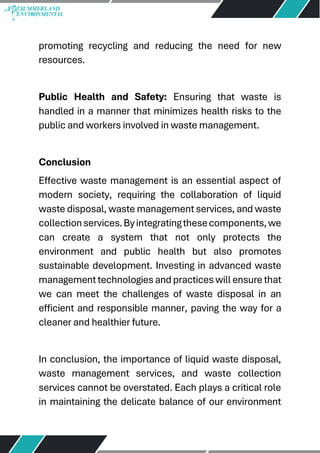Reclaim Waste Fundamentals Explained
Reclaim Waste Fundamentals Explained
Blog Article
The Of Reclaim Waste
Table of ContentsHow Reclaim Waste can Save You Time, Stress, and Money.The Basic Principles Of Reclaim Waste Little Known Facts About Reclaim Waste.Excitement About Reclaim WasteGetting My Reclaim Waste To Work
Discover the kinds, occurrences, and kinds of liquid waste. Residential sewage waste describes the waste and products from a residential septic storage tank. This sort of waste is developed by people in houses, colleges, and other structures. This only includes sewage-disposal tanks that have a drain area. The proper monitoring and disposal of domestic sewer waste require liquid waste to be moved to a sewage therapy plant where the appropriate methods and equipment are used to purify and dispose of waste.
Commercial waste typically consists of prospective risks, such as combustible materials or a blend of liquid and solid waste items, and calls for an advanced and comprehensive disposal procedure. The disposal of business waste generally includes the purification of waste before transportation to guarantee secure and correct disposal. Hazardous waste is created from by-products and overflow of industrial procedures and manufacturing.
This sort of waste can not make use of the same sewage administration transport or procedures as septic or business fluids. The commercial waste monitoring procedure calls for the examination and screening of fluid waste prior to it undertakes the disposal procedure (liquid waste disposal melbourne). Runoff waste is the liquid waste that comes from runoff and excess stormwater in highly populated areas or cities
Runoff waste can cause contamination and flooding if not dealt with correctly. Discover more about drain cleaning and waste administration. Making sure appropriate waste administration can avoid disasters and reduce environmental injury. Both people in household setups and specialists in commercial or production markets can take advantage of understanding the processes and guidelines of fluid waste monitoring.
See This Report on Reclaim Waste
Call PROS Providers today to discover our waste monitoring and disposal solutions and the appropriate methods to look after the fluid waste you generate.
(https://sitereport.netcraft.com/?url=https://reclaimwaste.com.au)Do you understand what happens to your water when you draw the plug, purge the bathroom or drain pipes the washing maker? No? Well, it's worth recognizing. This supposed 'wastewater' is not only a vital source but, after therapy, will be launched to our land, waterways or the sea. Utilized water from toilets, showers, baths, kitchen sinks, washings and commercial procedures is known as wastewater.

water used to cool equipment or clean plant and tools). Stormwater, a type of wastewater, is overflow that flows from farming and metropolitan areas such as roofing systems, parks, gardens, roads, courses and gutters right into stormwater drains pipes, after rainfall. Stormwater moves unattended directly to neighborhood creeks or rivers, eventually reaching the sea.
Reclaim Waste for Beginners
In Queensland, the majority of wastewater is treated at sewage treatment plants. Wastewater is moved from residential or industrial sites through a system of drains and pump terminals, recognized as sewage reticulation, to a sewage treatment plant. Regional governments develop, maintain and operate most sewage therapy plants. Operators are accredited under the Environmental Defense Act 1994 to release cured wastewater at an appropriate ecological criterion right into waterways.
The Department of Natural learn this here now Resources advises city governments regarding managing, operating and maintaining sewerage systems and therapy plants. In unsewered locations, city governments might call for homeowners to set up individual or household sewer treatment systems to treat domestic wastewater from toilets, kitchen areas, washrooms and laundries. The Department of Natural Resources authorises the usage of home systems when they are proven to be effective.
In some brand-new class, treatment of some stormwater to get rid of litter, sand and crushed rock has started utilizing gross toxin traps. Wastewater therapy occurs in 4 phases: Eliminates strong matter.
Uses small living microorganisms recognizes as micro-organisms to break down and get rid of remaining dissolved wastes and great fragments. Micro-organisms and wastes are incorporated in the sludge.
Our Reclaim Waste Statements
Nutrient elimination is not available in any way sewage treatment plants since it calls for pricey specialised devices. It is becoming much more common in Queensland. Clear fluid effluent generated after therapy might still consist of disease-causing micro-organisms. If this effluent is launched into waterways such as rivers or the sea, the micro-organisms will eventually die out.

The majority of wastewater streams into the sewage system. Under the Act, local federal governments provide authorizations and licences for environmentally appropriate tasks (Ages) involving wastewater launches that might have a neighborhood effect.
10 Easy Facts About Reclaim Waste Described
Monitoring provides factual information about water quality and can validate that licence problems are being fulfilled. The details obtained via monitoring provides the basis for making water quality decisions.
Report this page